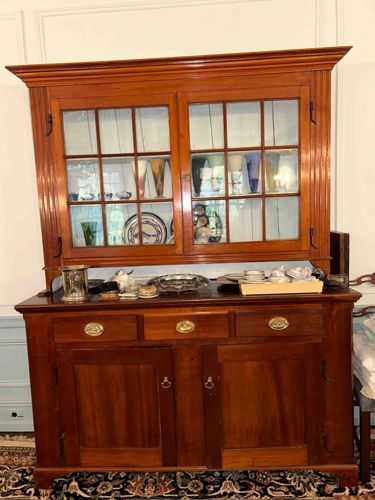
Early American Step-Back Hutch / China Cabinet
This is a two-piece Early American style step-back hutch or china cabinet, likely constructed from a rich-toned hardwood such as cherry or mahogany, exhibiting a warm reddish-brown hue. The upper section features a graceful cornice molding at the top, and two glass-fronted doors, each divided into multiple panes (likely 8 panes per door) by thin wooden muntins, creating a classic grid pattern. The glass panels appear clear, allowing visibility of the items displayed inside. Both upper doors are fitted with simple, dark-toned hinges, possibly wrought iron or a similar dark metal, visible on the exterior edges. Flanking the doors are reeded pilasters that add a decorative and structural element. The lower section is a solid base cabinet, slightly deeper than the upper hutch, providing a 'step-back' profile. It features three drawers across the top, each fitted with a brass circular pull with a central boss, typical of 18th or early 19th-century hardware. Below the drawers are two large cabinet doors, also constructed from solid wood panels, secured by similar simple dark hinges and adorned with brass keyhole escutcheons or pulls. The overall construction suggests sturdy craftsmanship, with traditional joinery. The piece shows a well-maintained patina, indicating age and regular use, but no significant visible damage, repairs, or extreme wear that would detract from its aesthetic. The style points to an estimated age from the late 18th to the mid-19th century, characteristic of Federal or early American country furniture. It is a functional and decorative piece primarily for display and storage.
AI-Generated Appraisal Disclaimer
Estimated Value
$1,800 - $3,000
Basic Information
Category
Furniture
Appraised On
December 20, 2025
Estimated Value
$1,800 - $3,000
Item Description
This is a two-piece Early American style step-back hutch or china cabinet, likely constructed from a rich-toned hardwood such as cherry or mahogany, exhibiting a warm reddish-brown hue. The upper section features a graceful cornice molding at the top, and two glass-fronted doors, each divided into multiple panes (likely 8 panes per door) by thin wooden muntins, creating a classic grid pattern. The glass panels appear clear, allowing visibility of the items displayed inside. Both upper doors are fitted with simple, dark-toned hinges, possibly wrought iron or a similar dark metal, visible on the exterior edges. Flanking the doors are reeded pilasters that add a decorative and structural element. The lower section is a solid base cabinet, slightly deeper than the upper hutch, providing a 'step-back' profile. It features three drawers across the top, each fitted with a brass circular pull with a central boss, typical of 18th or early 19th-century hardware. Below the drawers are two large cabinet doors, also constructed from solid wood panels, secured by similar simple dark hinges and adorned with brass keyhole escutcheons or pulls. The overall construction suggests sturdy craftsmanship, with traditional joinery. The piece shows a well-maintained patina, indicating age and regular use, but no significant visible damage, repairs, or extreme wear that would detract from its aesthetic. The style points to an estimated age from the late 18th to the mid-19th century, characteristic of Federal or early American country furniture. It is a functional and decorative piece primarily for display and storage.
Related Tags
Get Your Items Appraised
Instant estimates of your treasures with AI-powered instant appraisals